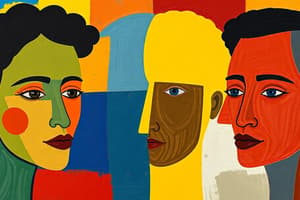Podcast
Questions and Answers
What is the primary distinction between stereotypes and prejudice?
What is the primary distinction between stereotypes and prejudice?
- Stereotypes are conscious, while prejudice is unconscious.
- Stereotypes are beliefs about group characteristics, while prejudice is a negative feeling toward a group. (correct)
- Stereotypes are attitudes, while prejudice are beliefs.
- Stereotypes are always negative, while prejudice can be positive or negative.
Which of the following best describes implicit bias?
Which of the following best describes implicit bias?
- A consciously held belief or attitude that someone expresses openly.
- A bias that only affects voting decisions.
- An unconscious and automatic association, assessed by reaction time measures. (correct)
- A bias measured through self-report questionnaires.
In the context of the Implicit Association Test (IAT), faster reaction times when pairing 'Black face' with 'Bad words' suggests what?
In the context of the Implicit Association Test (IAT), faster reaction times when pairing 'Black face' with 'Bad words' suggests what?
- A conscious belief that Black people are associated with negative traits.
- A lack of cultural awareness.
- A faster cognitive processing speed in general.
- An implicit bias associating Black people with negative concepts. (correct)
Which of the following is a criticism of the Implicit Association Test (IAT)?
Which of the following is a criticism of the Implicit Association Test (IAT)?
What impact does implicit bias have on behavior?
What impact does implicit bias have on behavior?
Which outcome was observed when individuals who were faster at pairing 'Black' with 'Bad words' were studied in relation to voting?
Which outcome was observed when individuals who were faster at pairing 'Black' with 'Bad words' were studied in relation to voting?
What did the study involving presenting a Black individual as a 'good person' and a firefighter to children demonstrate about changing implicit bias?
What did the study involving presenting a Black individual as a 'good person' and a firefighter to children demonstrate about changing implicit bias?
In the context of social psychology and bias, what key factor significantly influences behavior?
In the context of social psychology and bias, what key factor significantly influences behavior?
What did the Sinclair & Kunda study reveal about student ratings of professors based on course grade?
What did the Sinclair & Kunda study reveal about student ratings of professors based on course grade?
Which of the following strategies is MOST likely to reduce implicit bias, according to the text?
Which of the following strategies is MOST likely to reduce implicit bias, according to the text?
According to the information provided, what are the four conditions required for contact between groups to effectively reduce prejudice?
According to the information provided, what are the four conditions required for contact between groups to effectively reduce prejudice?
What does the text imply about the effectiveness of simple or minimal efforts to reduce prejudice?
What does the text imply about the effectiveness of simple or minimal efforts to reduce prejudice?
What characterizes 'institutional support' as one of the optimal conditions for intergroup contact to reduce prejudice?
What characterizes 'institutional support' as one of the optimal conditions for intergroup contact to reduce prejudice?
How is explicit bias typically measured?
How is explicit bias typically measured?
Why does reaction time play a crucial role in measuring implicit bias?
Why does reaction time play a crucial role in measuring implicit bias?
What is an important aspect of prejudice?
What is an important aspect of prejudice?
The content provided defines stereotypes as:
The content provided defines stereotypes as:
What is a true statement about schemas?
What is a true statement about schemas?
What is the ultimate goal of intergroup contact?
What is the ultimate goal of intergroup contact?
What is an example of implicit and explicit bias?
What is an example of implicit and explicit bias?
Flashcards
Stereotypes
Stereotypes
Beliefs about characteristics of a group's members.
Prejudice
Prejudice
Negative attitude toward a group, often automatic and unconscious.
Bias
Bias
A specific preference or inclination, which can be implicit or explicit.
Implicit Bias
Implicit Bias
Signup and view all the flashcards
Explicit Bias
Explicit Bias
Signup and view all the flashcards
Implicit Association Test (IAT)
Implicit Association Test (IAT)
Signup and view all the flashcards
Optimal Conditions for Contact
Optimal Conditions for Contact
Signup and view all the flashcards
Reducing Implicit Bias
Reducing Implicit Bias
Signup and view all the flashcards
Study Notes
- Stereotypes are beliefs about the characteristics of most members of a group and overall, these beliefs tend to be more positive.
- Prejudice is a negative attitude or feeling toward a group and its members, operating automatically and unconsciously.
- Schemas are applied to groups, and their content can be positive or negative.
Bias
- Bias is more specific than stereotypes or prejudice.
- Implicit bias is assessed via reaction time measures and signifies an unconscious and automatic association.
- Reaction time is faster when two things are closely related because they are easier to group.
Explicit Bias
- Explicit bias is measured by self-report skills, beliefs, and attitudes that people endorse.
Implicit Association Test (IAT)
- The IAT is most widely used and measures implicit bias by reaction time.
- Condition 1 involves pairing a bad word with a White face and a good word with a Black face.
- Condition 2 involves pairing a bad word with a Black face and a good word with a White face.
- Subjects tap using their left or right leg.
- Most people tap faster when pairing a Black face with bad words.
Criticism of IAT
- Order of representation impacts implicit bias, specifically which word is represented first, order does not matter.
- It is questioned whether bias represents an individual’s attitudes or cultural knowledge/awareness and remains controversial.
- An individual’s level of implicit bias predicts their behavior.
Impact of Implicit Bias
- Implicit bias impacts an individual’s decision-making.
- Implicit and explicit bias independently influenced voting decisions.
- People who rated faster for Black and bad words were less likely to vote for Obama.
- Females had an implicit bias against being in STEM programs.
Changing Implicit Bias
- Implicit bias can be reduced.
- A study on a Black individual being a good person and a firefighter to children changed IAT results, but had no lasting effect.
Social Psychology Theme
- Situation matters in social psychology and bias.
- The Sinclair & Kunda study evaluated rating professors when students earned a high course grade versus a low grade.
- Students with a high overall grade rated male and female professors equally.
- Students with a low overall grade rated female professors lower than male professors.
- Bias can be reduced by changing the situation.
Contact Between Groups
- Contact between groups reduces prejudice only under optimal conditions, needing to meet all four.
- The conditions needed are:
- Equal status between groups
- Intimate and varied contact, in order for people to get to know each other
- Cooperation to achieve a shared goal
- Institutional support, contact approved by culture and authority
- Reduction of prejudice requires sophisticated designing.
- Reducing prejudice is not easy, must be skeptical of tiny changes because they are not typically effective, but it is possible.
Studying That Suits You
Use AI to generate personalized quizzes and flashcards to suit your learning preferences.




